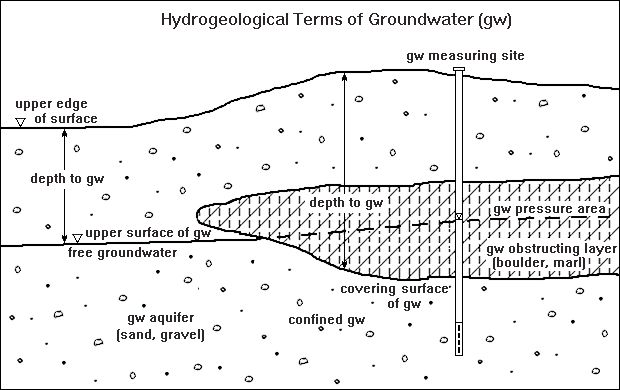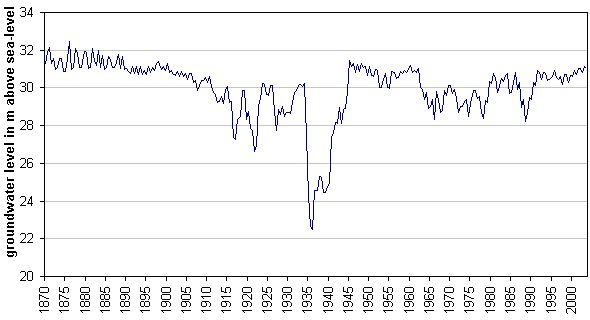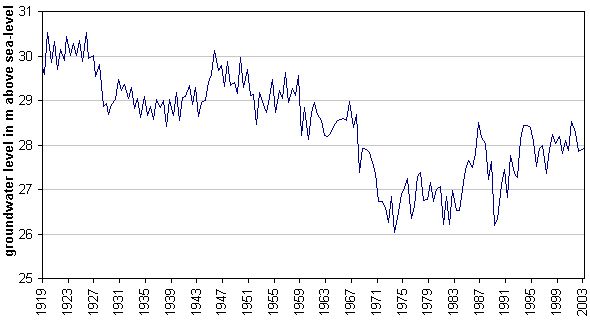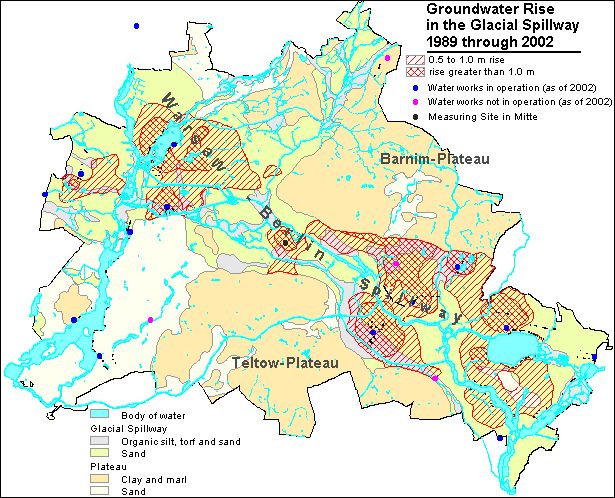During the ensuing period, from the early ‘50’s to the early ‘80’s, the groundwater level sank continually and over large areas because of increased withdrawal. This was particularly noticeable in water production areas (waterworks facilities). The lowering was caused by the general rise in water consumption by private households, and by construction (rebuilding of the severely destroyed city, subway construction, and large-scale construction projects). The expansion of water production facilities in the West Berlin waterworks was completed by the beginning of the ‘70’s. The expansion of the Friedrichshagen Waterworks in East Berlin began in the mid-‘70’s, to supply water to the new residential areas in Hellersdorf, Marzahn and Hohenschönhausen.
A slight rise in groundwater levels has occurred in West Berlin since the end of the 70’s.
A number of reasons can be given for this rise: reduced withdrawal from private wells; reduced withdrawal at construction sites (a lower construction volume and enforcement of groundwater return); reduced withdrawal volumes by public waterworks; and, not least, effective anthropogenic groundwater recharging (cf. Map 02.11).
Following the political changes in 1989 (fall of the Berlin Wall), the level of water consumption in the eastern boroughs of Berlin was drastically reduced, and the production at the waterworks in those areas dropped an estimated 50 %. This resulted in a rise in the groundwater level throughout the city, east and west. Since then, it has kept relatively steady at this high level; a further increase has not been observed, however (cf. p. & Ch. Basic Data).
Those areas nearest to waterworks recorded level increases of as high as 3 m during the mid-‘90s. The Berlin Pleistocene Watercourse (or glacial spillway), which covers half the area of the city, has a very low depth to groundwater of only a few meters. Many of the cellars in some areas were not sealed appropriately, and therefore suffered damage through dampness due to a sudden increase in groundwater during this period. In two areas, the damage was so extensive that it was necessary to implement groundwater regulatory measures (Rudow, Kaulsdorf).
Permanent, wide and deep cones of depression have formed in water catchment areas around waterworks wells. The considerable differences observable among groundwater levels are directly related to variations in withdrawal requirements at the respective waterworks. Riemeister Lake and Nikolas Lake were dried out by the water withdrawals of the Beelitzhof Waterworks at the beginning of this century. The groundwater level of the Schlachten Lake fell by 2 m, and at Krumme Lanke by 1 m. Since 1913, water from the Havel has been withdrawn into the Grunewald lakes (inversion of natural flow) to balance this loss. The wetlands of Hundekehlefenn, Langes Luch and Riemeisterfenn, as well as the shore areas of the lakes have been saved by this measure.
The cones of depression around well galleries at the Havel Lake have effects deep into the Grunewald (forest). The groundwater level at Postfenn sank by 3.5 m between 1954 and 1974, and at Pechsee in the Grunewald by about 4.5 m between 1955 and 1975. Well gallery withdrawals at banks of the Havel have caused severe drying out of root soils of plants in the direct vicinity of the Havel.
About 90% of the wetlands around Müggel Lake in southeastern Berlin are threatened (Krumme Laake, Müggelheim, Teufelsseemoor, Neue Wiesen/Kuhgraben, Mostpfuhl, Thyrn, the lower course of Fredersdorfer Fliess).
Some wetland areas were flooded and given seepage of surface water to moderate negative effects caused by the lowering of groundwater levels. These were the West Berlin nature reserves Grosser Rohrpfuhl and Teufelsbruch in the Spandau Forest, and Bars Lake in Grunewald; in East Berlin, Krumme Laake in Grünau and Schildow in Pankow.
Large-scale lowering of groundwater levels has also occurred in the Spandau Forest, caused by the higher withdrawals by the Spandau Waterwork since the 70’s. A groundwater recharging plant, operated since 1983, percolates purified Havel water in an attempt to gradually raise groundwater levels. The groundwater level in the Spandau Forest had been raised by an average of 0.5 – 2.5 m by May 1987. Groundwater recharging in this area has been restricted again because water has appeared in cellars of near-by residential areas. The simultaneously increase in withdrawal amounts of the Spandau Waterwork lowered the groundwater level again after 1990. In the following period, the groundwater level rose once more, due to the further reduction of withdrawal amounts.




